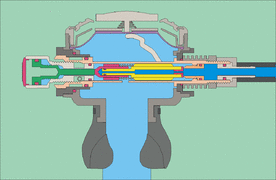How does a diving regulator work?
We service regulators from many different manufacturers and although they are all different in their design they are all trying to achieve the same thing.
Here’s a quick overview of how a regulator works
1) The main function of the regulator is to take the pressurised air (or gas mix) in your cylinder and reduce its pressure to the ambient pressure the diver is breathing at.
2) In a standard recreational diving set-up, there are two “stages” a first stage that is attached to the cylinder valve and a second stage that is a demand valve that is held in the diver’s mouth.
3) The first stage will either have a DIN or A clamp fixing and its job is to take the high pressure in your cylinder of typically around 200 bar down to an intermediate pressure of around 8 to 10 bar. This lower pressure gas is then fed through a low pressure hose to the second stage demand valve in the diver’s mouth.

4) When the diver breathes in, generally a spring loaded valve opens in the direction of the gas flow and flows into the mouthpiece. If the first stage has a leak or has over pressure, the excess pressure can force the spring loaded valve open and cause a free flow. The animation shows a typical second stage valve working.
5) A manual purge button allows the diver to manually operate the valve to clear the mouthpiece of water.
6) Many valves give you some control with a + / – flow control on the side of the second stage that makes it harder or easier for the valve to open. This is helpful sometimes when planning deeper dives.
Regulators are very reliable and have to be as they are crucial to safe diving but some common problems include:
1) Free flow of gas often caused by some part sticking open.
2) Freezing due to very cold conditions, hence why specialist cold water regulators exist. You may also see freezing caused by free flowing gas as the temperature drops when this happens and often causes the free flow to get worse.
3) Wet breathes often caused by damaged parts in the second stage leaking.
4) Juddering when a breath is taken which is generally due to an irregular flow of gas from the second stage.
There is a lot more technical detail available online so if you want to do more research here’s a good place to start.
If you are having any issues with your own regulators then please get in touch and we would be happy to advise. It’s a key item of your equipment so it’s important they are well looked after and regularly serviced.
[/et_pb_text][/et_pb_column][/et_pb_row][/et_pb_section]

